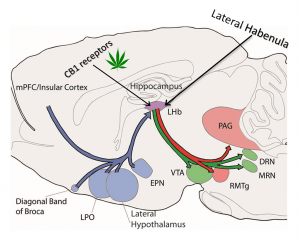 Featured Paper of the Month – October 2021
Featured Paper of the Month – October 2021
Published in Neuropharmacology by Agustin Zapata and Carl R Lupica in the NIDA IRP Electrophysiology Research Section.
Summary
Studies show that cannabis increases relapse to cocaine seeking following withdrawal, and in humans cannabis and cocaine use are associated with impulse control deficits. We showed previously that an area of the brain known as the lateral habenula (LHb) is involved in inhibiting operant responses for cocaine in rat self-administration studies. Therefore, the present study was conducted to determine if the LHb controls impulsivity caused by acute cocaine or the primary psychoactive component of cannabis know as Δ9-tetrahydrocannabinol (Δ9-THC). Using a task to measure impulsivity, attention, and motivation, known as the 5 choice serial reaction time task (5CSRTT) in rats, we found that both cocaine and Δ9-THC, at select systemic doses, selectively increased impulsive behavior without affecting attention and motivation. Then, using the 5CSRTT we found that the pro-impulsive effects of both drugs were prevented by blocking cannabinoid CB1 receptors with an antagonist in the LHb. This provides the first evidence that the LHb endogenous cannabinoid system may be involved in drug-associated impulsive behavior. Finally, we also found that Δ9-THC increased impulsive cocaine seeking during self-administration and this was also prevented by blocking LHb CB1Rs. Together these experiments show that CB1Rs in the LHb are involved in impulsive drug-related behavior and that the LHb endocannabinoid system could represent a viable target for therapies to decrease drug seeking in humans.
Publication Information
Lateral habenula cannabinoid CB1 receptor involvement in drug-associated impulsive behavior Journal Article
In: Neuropharmacology, vol. 192, pp. 108604, 2021, ISSN: 1873-7064.
